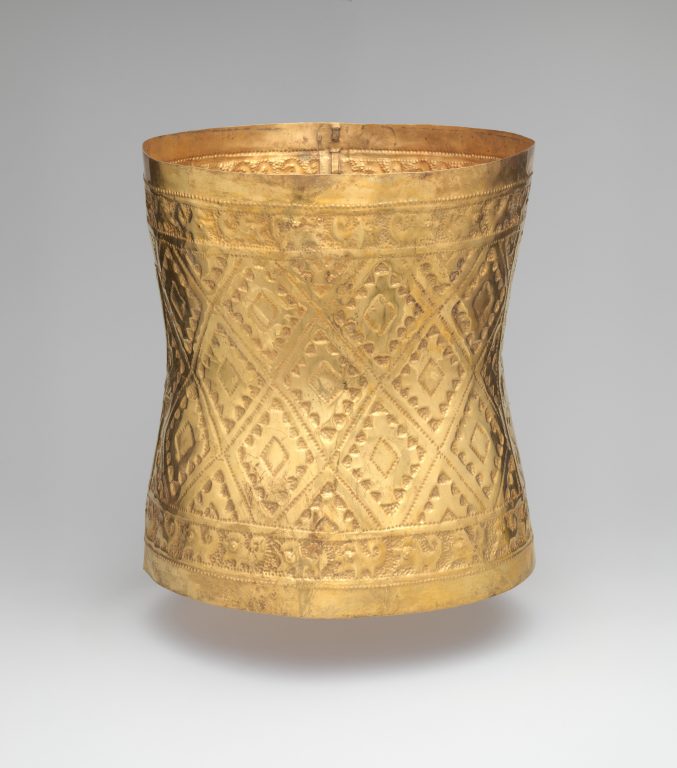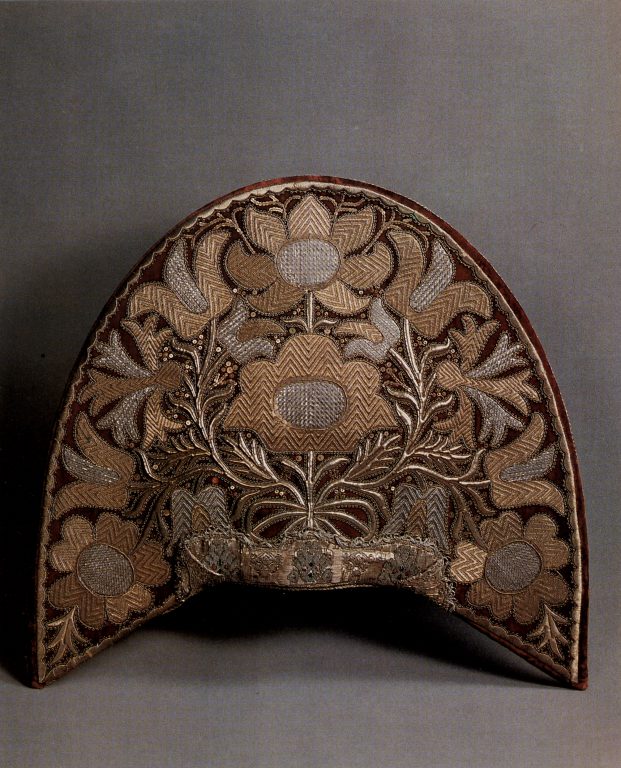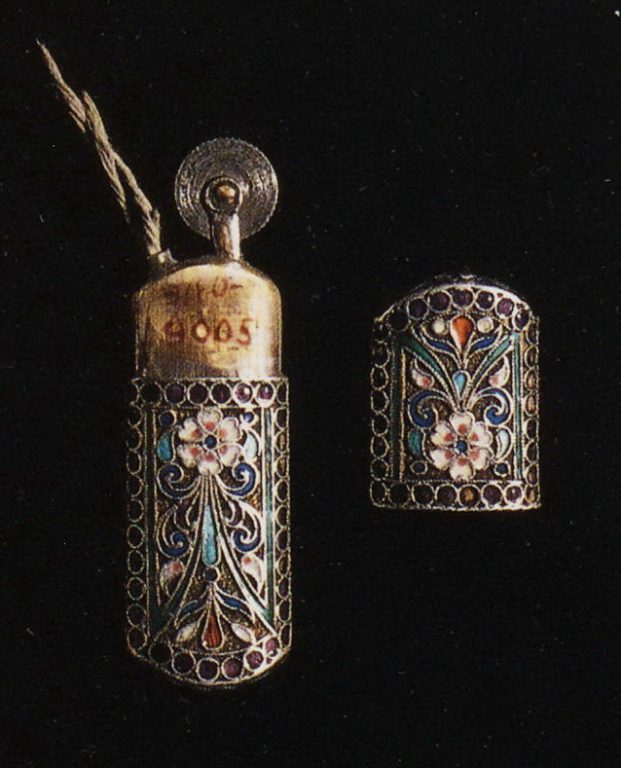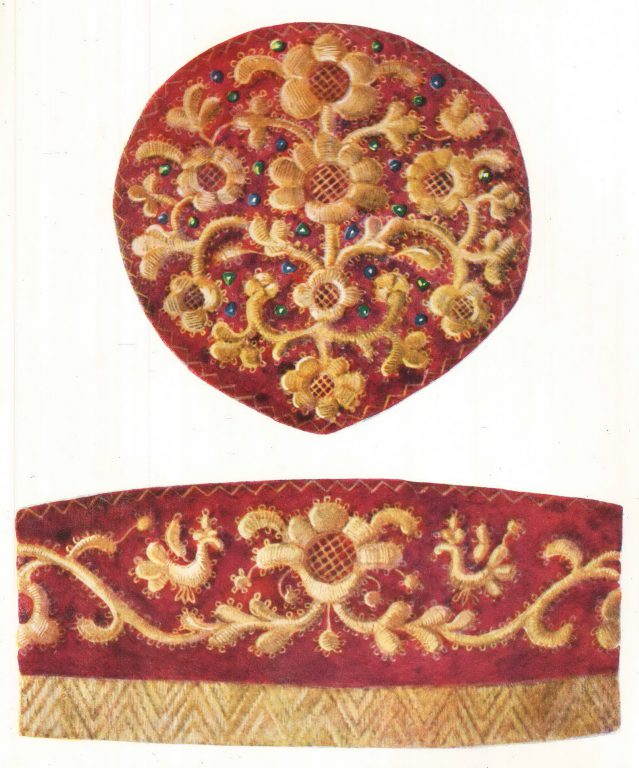

South America
-
Objectheadwear: Crown
-
Type of arts & crafts
-
MediumGold
-
SizeH. 8 1/4 Г— Diam. 7 1/4 in. (21 Г— 18.4 cm)
-
Geography details
North Coast district,
South America -
Country today
-
DateA.D. 900-1100
-
CultureLambayeque (SicГЎn)
-
Type of sourceDatabase “Metropolitan Museum of Art”
-
Fund that the source refers toMetropolitan Museum of Art
-
Cylindrical crowns that taper gently in the middle were common in high-status tombs at Batán Grande, a site now called the Sicán Archaeological Precinct, in the Santuario Histórico Bosque de Pómac, about 40 kilometers northeast of the modern city of Chiclayo on Peru’s North Coast. Made of sheet metal—in this case, an alloy of 44 percent gold, 32 percent silver, and 24 percent copper—it was worked from behind (repoussé) and from the front into a textile-like stepped-diamond pattern contained within an upper and lower border of animals in profile. The ends of the sheet were joined by metal lacing, as if it were a cloth.
The Sicán tombs, located deep in monumental mudbrick platforms, held nearly unimaginable quantities of objects made of precious metal, shell, and cloth. A single tomb could contain as many as five such crowns, some featuring delicate openwork, and others, such as the present example, displaying repoussé designs. The repoussé stepped-diamond shapes seen here are further enhanced by stippling or pinhead patterning in the background and along the borders, achieved using a punch on the front of the sheet. A vertical band of wave motifs flanked by plain borders interrupts the diamond patterning on either side of the crown. The crown’s upper and lower borders contain a band of creatures with a curly tail, a crested head, a wide-open maw, and protruding, circular eyes rendered in higher relief. Pairs of irregularly shaped perforations, perhaps used to attach feathers or other elements now lost, are located in several places along the upper border.
The stepped-diamond shape becomes particularly popular in later periods on Peru’s North Coast, and is seen in the architectural sculpture at Chan Chan, capital of the Chimú empire, and on Inca-period ceramics.
Joanne Pillsbury, Andrall E. Pearson Curator, Arts of the Ancient Americas, 2018
References and Further Reading
Carcedo Muro de Mufarech, Paloma, and Izumi Shimada. “Behind the Golden Mask: Sicán Gold Artifacts from Batán Grande, Peru.” In The Art of Precolumbian Gold: The Jan Mitchell Collection, edited by Julie Jones, pp. 60–75. New York: The Metropolitan Museum of Art, 1985.
Elera, Carlos G. “The Face Behind the Mask.” In Peru: Kingdoms of the Sun and the Moon, edited by Victor Pimentel, pp. 96–107. Montreal: Montreal Museum of Fine Arts, 2013.
Jones, Julie, and Heidi King. 2002. “Gold of the Americas.” The Metropolitan Museum of Art Bulletin 59 (4): 1–59.
Lechtman, Heather. “Issues in Andean Metallurgy.” In Pre-Columbian Metallurgy of South America, edited by Elizabeth P. Benson, pp. 1–40. Washington, DC: Dumbarton Oaks Research Library and Collection, 1977.
Pillsbury, Joanne. “Reading Art without Writing: Interpreting Chimú Architectural Sculpture.” In Dialogues in Art History, from Mesopotamian to Modern: Readings for a New Century, edited by Elizabeth Cropper, pp. 72–89. Studies in the History of Art 74. Center for Advanced Study in the Visual Arts Symposium Papers 51. Washington, DC: National Gallery of Art, 2009.
Pillsbury, Joanne. “Luminous Power: Luxury Arts in the Ancient Americas.” In Golden Kingdoms: Luxury Arts in the Ancient Americas, edited by Joanne Pillsbury, Timothy F. Potts, and Kim Richter, pp. 1-13. Los Angeles: The J. Paul Getty Museum, 2017.
Pillsbury, Joanne. “Imperial Radiance: Luxury Arts of the Inca and their Predecessors.” In Golden Kingdoms: Luxury Arts in the Ancient Americas, edited by Joanne Pillsbury, Timothy F. Potts, and Kim Richter, pp. 33-43. Los Angeles: The J. Paul Getty Museum, 2017.
Shimada, Izumi. Cultura Sicán: Dios, riqueza y poder en la costa norte del Perú. Lima: Fundación del Banco Continental para el Fomento de la Educación y la Cultura, Edubanco, 1995.
Shimada, Izumi. “The Late Prehispanic Coastal States.” In The Inca World, edited by Laura L. Minelli, pp. 49–110. Norman: University of Oklahoma Press, 2000.
Shimada, Izumi, Jo Ann Griffin, and Adon Gordus. “The Technology, Iconography, and Social Significance of Metals: A Multi-Dimensional Analysis of Middle Sicán Objects.” In Precolumbian Gold: Technology, Style and Iconography, edited by Colin McEwan, pp. 28–61. London: British Museum, 2000.
Shimada, Izumi, ed. Cultura Sicán: Esplendor preincaico de la costa norte. Translated by Gabriela Cervantes. Lima: Fondo Editorial del Congreso del Perú, 2014.


























